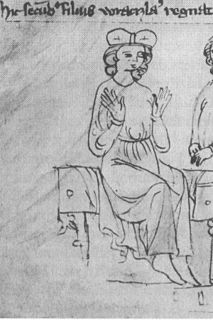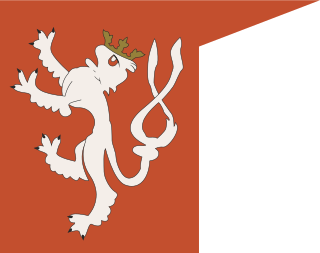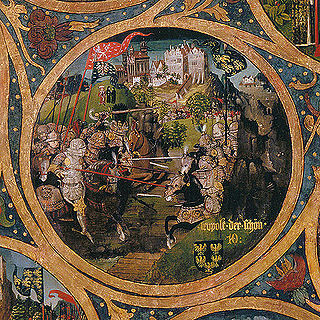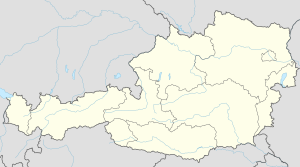
VratislausI, a member of the Přemyslid dynasty, was Duke of Bohemia from 915 until his death.

(Saint) Wenceslaus I, Wenceslas I or Václav the Good was the duke (kníže) of Bohemia from 921 until his assassination in 935. His younger brother, Boleslaus the Cruel, was complicit in the murder.

Year 1082 (MLXXXII) was a common year starting on Saturday of the Julian calendar.

Boleslaus I the Cruel, also called Boleslav I, a member of the Přemyslid dynasty, was ruler of the Duchy of Bohemia from 935 to his death. He is notorious for the murder of his elder brother Wenceslaus, through which he became duke. Despite his complicity in this fratricide, Boleslaus is generally respected by Czech historians as an energetic ruler who significantly strengthened the Bohemian state and expanded its territory. His accomplishments include significant economic development due to an expansion in trade, the introduction of silver mining and the minting of the first local coinage, the Prague denarius.

The Battle of White Mountain was an important battle in the early stages of the Thirty Years' War.

The Duchy of Bohemia, also later referred to in English as the Czech Duchy, was a monarchy and a principality of the Holy Roman Empire in Central Europe during the Early and High Middle Ages. It was formed around 870 by Czechs as part of the Great Moravian realm. The Bohemian lands separated from disintegrating Moravia after Duke Spytihněv swore fidelity to the East Frankish king Arnulf in 895.

Bretislav I, known as the "Bohemian Achilles", of the Přemyslid dynasty, was Duke of Bohemia from 1035 until his death.

The Kingdom of Bohemia, sometimes later in English literature referred to as the Czech Kingdom, was a medieval and early modern monarchy in Central Europe, the predecessor of the modern Czech Republic. It was an Imperial State in the Holy Roman Empire, and the Bohemian king was a prince-elector of the empire. The kings of Bohemia, besides Bohemia, also ruled the Lands of the Bohemian Crown, which at various times included Moravia, Silesia, Lusatia, and parts of Saxony, Brandenburg, and Bavaria.

Cosmas of Prague was a priest, writer and historian born in a noble family in Bohemia. Between 1075 and 1081, he studied in Liège. After his return to Bohemia, he became a priest and married Božetěcha, with whom he probably had a son. In 1086, Cosmas was appointed prebendary (canonicus) of Prague, a prestigious position. As prebendary he also travelled through Europe on official matters.

The Přemyslid dynasty or House of Přemyslid was a Czech royal dynasty which reigned in the Duchy of Bohemia and later Kingdom of Bohemia and Margraviate of Moravia, as well as in parts of Poland, Hungary, and Austria.

Drahomíra of Stodor was Duchess consort of Bohemia from 915 to 921, wife of the Přemyslid duke Vratislaus I. She also acted as regent of the Duchy of Bohemia from 921 to 924 during the minority of her son Wenceslaus. She is chiefly known for the murder of her mother-in-law Ludmila of Bohemia by hired assassins.

Frederick, a member of the Přemyslid dynasty, was Duke of Bohemia from 1172 to 1173 and again from 1178 to his death.

St. George's Basilica is the oldest surviving church building within Prague Castle, Prague, Czech Republic. The basilica was founded by Vratislaus I of Bohemia in 920. It is dedicated to Saint George.

Świętosława of Poland was the third wife of Duke Vratislaus II of Bohemia and the first Queen of Bohemia as of 1085.

Kłodzko Land is a historical region in southwestern Poland. A Bohemian domain since the 12th century and raised to the County of Kladsko in 1459, it was conquered by Prussia in the First Silesian War of 1740-42 and incorporated into the Province of Silesia by 1818. After World War II it fell to the Republic of Poland according to the 1945 Potsdam Agreement.
Luitpold of Znojmo, a member of the Přemyslid dynasty, ruled as Moravian duke of Znojmo for twenty years - from 1092 until his death.
The Czech Corner is a territory found in the western end of Klodzko land, close to the current Czech-Polish border. This area consisted of eleven villages which were inhabited by Bohemian Czechs.

Conrad II of Znojmo, a member of the Přemyslid dynasty, was a Bohemian prince who ruled in the Moravian principality of Znojmo from 1123 to 1128 and again from 1134 until his death.























